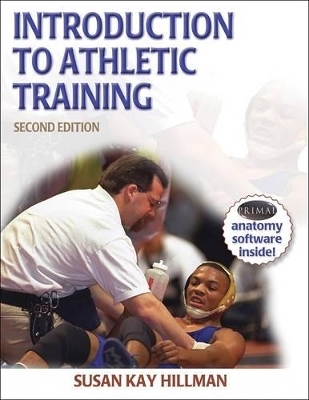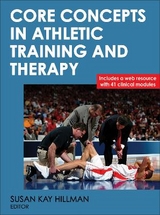
Introduction to Athletic Training
Human Kinetics Publishers
978-0-7360-5292-4 (ISBN)
- Titel erscheint in neuer Auflage
- Artikel merken
Susan Kay Hillman, ATC, PT, is associate professor and director of Human Anatomy at the Arizona School of Health Sciences, a division of the A.T. Still University. She has more than 13 years of experience as head athletic trainer for the University of Arizona and has served as a consultant, assistant athletic trainer, and physical therapist for the Pittsburgh Steelers as well as the Philadelphia Eagles football clubs. Hillman has served on the editorial board of the journal Athletic Therapy Today and the review board of the Journal of Sport Rehabilitation. She is a member of the Rocky Mountain Athletic Trainers Association (RMATA) Program Committee. In 2004, she received the Distinguished Educator Award from the RMATA, and the year before she was named Most Distinguished Athletic Trainer by the National Athletic Trainers' Association (NATA). Hillman earned a master's degree in physical therapy from Stanford University and a master's degree in physical education and athletic training from the University of Arizona, as well as a bachelor's degree in the same field from Purdue University.
Chapter 1. Athletic Training: The Profession and Its History-What Are the Characteristics of a Profession?-What Makes Athletic Training a Profession?-The History of Athletic Training-Employment Opportunities in Athletic Training-The Sports Medicine Team-Learning AidsChapter 2. Epidemiology of Athletic Injuries-Research in Sports Epidemiology-Sports Injury Surveillance Systems-Injury Trends-High-Risk Sports-Other Sports-Intrinsic Risk Factors-Learning AidsChapter 3. The Preparticipation Physical Examination-The Essential Elements of the Preparticipation Physical Examination-Health Status Information-The Physical Components of the Preparticipation Physical Examination-Fitness or Performance Testing-Preparticipation Physical Examination Results-Considerations for Athletes With Impairments-Administration of the Preparticipation Physical Examination-Learning AidsChapter 4. Conditioning and Strength Training in Athletics-Fitness-Testing Procedures-Fitness-Testing Parameters-Exercise Prescription-Developing the Strength-Training Program-Types of Strength Training-Equipment Selection-Integrating Other Fitness Components-Preventing Injury Through Strength and Conditioning-Learning AidsChapter 5. Pharmacology in Athletic Medicine-Understanding Pharmacology-Drug Nomenclature and Classification-The Study of Drugs-Drug Testing Policies and Procedures-Drugs Specific to Athletic Related Conditions-Non-Orthopedic Medicinals-Learning AidsChapter 6. Environmental Conditions-Temperature Regulation and Heat Exchange-Physiological Responses to Exercise in the Heat-Cooling Mechanisms-Adapting to Environmental Heat-Heat Illness-Prevention of Heat-Related Illness-Caring for Heat Illness-Cold Environments-Other Weather Conditions-Other Environmental Factors Influencing Sport Participation-Learning AidsChapter 7. Protective Devices, Regulations, and the Law-Energy Absorption and Force Dissipation-Standards for Equipment Design and Reconditioning-Regulating Agencies-Reconditioning and Maintenance of Athletic Headgear-Agencies for Development of Sport Safety Rules-Legal Concerns About Equipment Use in Sport-Liability Negligence-Determination of Liability-Product and Manufacturer Liability-Protecting Oneself From Legal Misfortune-Learning AidsChapter 8. Emergency Care and Medical Management of Athletic Injury-First Aid, Emergency Care, and Cardiopulmonary Resuscitation-Legal and Ethical Issues in Treatment-Community-Based Emergency Medical Services-Community-Based Emergency Care Facilities-Emergency Care Equipment and Supplies-Referring the Athlete for Further Care-Transmission of Bloodborne Pathogens-Learning AidsChapter 9. Nutritional Aspects of Health and Performance-Why Study Nutrition?-Basic Nutritional Needs of Athletes-Fluid Needs for Active Individuals-Caloric Demands of Active Individuals-The Food Guide Pyramid-Planning the Athlete's Diet-Learning AidsAppendix A: National Athletic Trainers' Association Code of EthicsAppendix B: Historical Perspective on the National Athletic Trainers' Association
| Erscheint lt. Verlag | 16.12.2004 |
|---|---|
| Reihe/Serie | Athletic Training Education S. |
| Zusatzinfo | 43 black & white illustrations, 147 black & white halftones |
| Verlagsort | Champaign |
| Sprache | englisch |
| Maße | 216 x 279 mm |
| Themenwelt | Medizin / Pharmazie ► Medizinische Fachgebiete ► Sportmedizin |
| ISBN-10 | 0-7360-5292-5 / 0736052925 |
| ISBN-13 | 978-0-7360-5292-4 / 9780736052924 |
| Zustand | Neuware |
| Informationen gemäß Produktsicherheitsverordnung (GPSR) | |
| Haben Sie eine Frage zum Produkt? |
